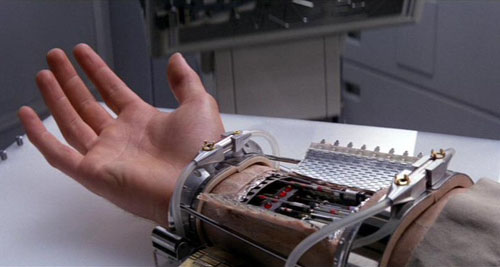After looking through my media center PC, The Adjustment Bureau happened to be the highest rated movie that I hadn’t seen in the science fiction category. I wasn’t sure exactly what to expect, other than a 7.1 metascore from IMDb. About 20 minutes into the film, I realized that this was probably one that my wife would enjoy. The best I could categorize this movie would be romantic science fiction.
The Adjustment Bureau starts out by following the end of a political campaign for Senate. David Norris (Matt Damon) ends up losing the election because of a leaked photo of him mooning someone at his college reunion. Seeking some privacy, he goes to the men’s restroom to prepare his speech. After a while, a woman pops out of a stall, apologizing for the intrusion. She was hiding out in the men’s room to avoid security for being a wedding crasher. They begin to exchange witty banter about her situation and his unfortunate downfall.
This slowly builds up as some type of emotional connection is being created, then they kiss and are immediately interrupted by David’s campaign manager. The woman runs out, with David close behind. He’s about to do the cliche “Who are you, where have you been my whole life?” type of thing when security guards show up and chase her out of the building, and David’s life, presumably for good. I’m pretty sure he never even got her name. David goes out to deliver his prepared speech, but seems to drop the fake politician act and gets “real” with his supporters. This evidently is the result of his encounter in the bathroom.
About this time, I’m starting to wonder where the Sci-Fi comes in. Following the speech, there is a meeting between two guys in suits and hats on a park bench. An older guy talks to another that appears to be David’s handler. David needs to spill his coffee by 7:05 AM. Of course the guy falls asleep and misses his opportunity to make David spill his coffee. Instead, David gets on a bus and low and behold, who’s there? You guessed it, the girl from the bathroom, which turns out to be named Elise (Emily Blunt). The rest of the movie revolves around the men in suits trying to keep David and Elise apart.
I initially thought that the guys in suits were time travelers, intent on keeping a terrible future from happening, kind of like in the Terminator. The role of the Adjustment Bureau is a bit different, with some elements of the Matrix without the virtual reality. There is a “Plan” and “The Chairman” *cough* Architect *cough* with the agents that are tasked with keeping everything running smoothly. The encounter with Elise was part of the plan, but not David bumping into her ever again. Toward the end, it seemed like the writers were trying to get a bit more philosophical than a movie of this class could pull off. Overall, it was a decent movie, but not really what I expected. Guys, next time your girl wants to watch a “chick flick,” think about suggesting this movie. I honestly think it is one that both of you could enjoy.
One thing I didn’t expect when the credits started to roll was that this movie was inspired by the short story “The Adjustment Team” written by Philip K. Dick. I knew a good number of his stories had been made into movies, but I didn’t realize this was one of them. One of my favorite movies before I started reading his work was Total Recall, based on the story “We Can Remember it for You Wholesale.” I think I might start tracking down the stories that match up with movies and review those sometime in the future.


